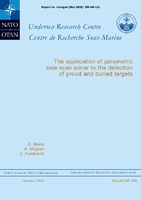| dc.description.abstract | This paper describes an experiment designed to evaluate the feasibility of using the TOPAS parametric transmitter mounted in side scan mode, for the detection of buried targets. The concept was tested with proud targets in order to evaluate the detection ranges achieved for low and high frequencies of the parametric sonar. The performance against buried targets has been estimated by means of a simple model based on Lambert's law. Detection of a variety of cylindrical proud targets on a sandy bottom has been achieved in reverberation and noise limited conditions up to a range of 750 m, using both the primary (40 kHz) and secondary frequencies (2 to 12 kHz) of the parametric source. In reverberation, short, broadband, Ricker pulses were used to improve the range resolution of the sonar, while at longer range 10 ms LFM pulses were transmitted to counter the noise level. The secondary frequency of the TOPAS achieved better results: the LF mode of operation achieved 30 detections against a mine field of six different targets and 10 detections against a cluster of three targets. The HF mode had only 15 detections against the mine field, and 10 detections against the cluster. Comparing the Signal to Background Ratio (SBR) for all targets detected by both HF and LF, the LF outperforms the HF. Although the TS of the targets should theoretically increase from LF to HF, the SBR is in average about 2 dB higher at low frequency. The conditions of the experiment were modelled with a simple sonar equation based on Lambert's law. There is good agreement between modelled and measured target echo levels. Measured reverberation is higher than that predicted by Lambert's law. A parametric study was performed to assess the amount of extra loss that the sonar could afford, when the transmitted pulses propagate into the sediment. The proposed sonar was unlikely to detect a target of -18 dB buried in sand, if the extra transmission loss into the sediment exceeds 2 dB (one way propagation). This negative result can be partly overcome by a longer receiver to improve horizontal resolution. The effect of an 128 element array has also been modelled and the upgraded sonar should be capable of achieving detections of a -18 dB target buried in sand, with one way transmission loss of the order of 6 or 7 dB. | |
